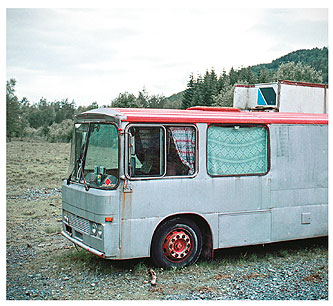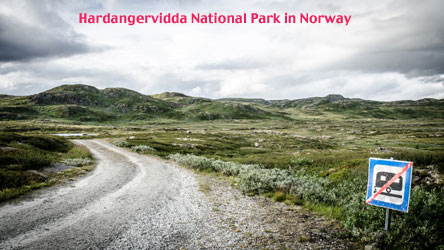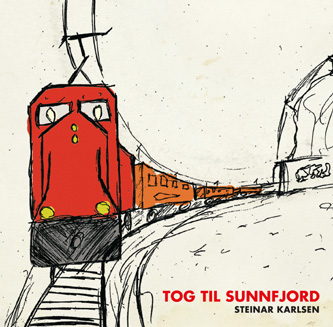 Norwegian
guitarist Steinar Karlsen has developed a near cult like following
among international fretboard watchers since the release of his first
solo album Ulydium in 2011. In 2013, he followed with Hanens
Død and in 2015 Steinar has returned with two intriguing
albums of all new guitar instros. First off, Tog Til Sunnfjord
(Fantasy Train) features ten instrumental tracks that
sound guitar noir in places. That Karlsen effect on guitar is in full
evidence and overall the album may be sparse but it’s effective
and guitar fans will dig it. Cool thing is on Fantasy Train, Steinar
plays all instruments giving it an overall stark, Norwegian guitar
edge. It’s as if David Lynch moved to Oslo and started playing
surf-rock guitar. Even better is the other 2015 CD release of TUR,
Steinar’s latest solo album. More in the vein of his earlier
albums, TUR features Steinar backed up by a full band, including
drums, keyboards, bass and more. Speaking to mwe3.com about his unique
recording approach, Steinar adds, "Every time I make an album
I feel I learn something and hopefully grow a bit. I think with Tog
til Sunnfjord and Tur my song writing has changed a bit, but without
loosing the signature. It is hard to say if I will stay on the same
track for the next album. I have always tried something new."
Steinar tastefully proves himself on all electric guitars, organ,
percussion and synths. Despite the cryptic cover art and song titles
in Norwegian, TUR is as good as it gets for fans of 21st century
instrumental guitar sounds. Don’t forget ECM guitarist Terje
Rypdal got his start as a surf guitar instrumentalist who was influenced
by Hank Marvin, Link Wray and others of that reknown... and clearly,
Steinar has listened to them all. With these two 2015 albums, Steinar
Karlsen brings the art of instrumental rock guitar to a higher caliber
of sonic greatness. www.orangutwangmusic.com
/ www.steinarkarlsen.no
Norwegian
guitarist Steinar Karlsen has developed a near cult like following
among international fretboard watchers since the release of his first
solo album Ulydium in 2011. In 2013, he followed with Hanens
Død and in 2015 Steinar has returned with two intriguing
albums of all new guitar instros. First off, Tog Til Sunnfjord
(Fantasy Train) features ten instrumental tracks that
sound guitar noir in places. That Karlsen effect on guitar is in full
evidence and overall the album may be sparse but it’s effective
and guitar fans will dig it. Cool thing is on Fantasy Train, Steinar
plays all instruments giving it an overall stark, Norwegian guitar
edge. It’s as if David Lynch moved to Oslo and started playing
surf-rock guitar. Even better is the other 2015 CD release of TUR,
Steinar’s latest solo album. More in the vein of his earlier
albums, TUR features Steinar backed up by a full band, including
drums, keyboards, bass and more. Speaking to mwe3.com about his unique
recording approach, Steinar adds, "Every time I make an album
I feel I learn something and hopefully grow a bit. I think with Tog
til Sunnfjord and Tur my song writing has changed a bit, but without
loosing the signature. It is hard to say if I will stay on the same
track for the next album. I have always tried something new."
Steinar tastefully proves himself on all electric guitars, organ,
percussion and synths. Despite the cryptic cover art and song titles
in Norwegian, TUR is as good as it gets for fans of 21st century
instrumental guitar sounds. Don’t forget ECM guitarist Terje
Rypdal got his start as a surf guitar instrumentalist who was influenced
by Hank Marvin, Link Wray and others of that reknown... and clearly,
Steinar has listened to them all. With these two 2015 albums, Steinar
Karlsen brings the art of instrumental rock guitar to a higher caliber
of sonic greatness. www.orangutwangmusic.com
/ www.steinarkarlsen.no
mwe3.com presents an interview with
STEINAR KARLSEN
 mwe3:
In 2015 you released two new albums, Tog Til Sunnfjord and
more recently Tur. You must have had a lot of music inside
you. How would you compare the two? Both are filled with excellent
guitar instrumental sounds.
mwe3:
In 2015 you released two new albums, Tog Til Sunnfjord and
more recently Tur. You must have had a lot of music inside
you. How would you compare the two? Both are filled with excellent
guitar instrumental sounds.
Steinar Karlsen: Well this year has been productive. I went
to the studio to record Tur. When I had finished the record
I had some more songs. The recording of Tur inspired me so
much I continued writing and recording music for Tog til Sunnfjord
(meaning “Train To Sunnfjord”). The record is about a non
existent train travel on the west coast of Norway from Bergen where
I live, to the area Sunnfjord where I grew up. Many years ago there
were actual plans for making a railway in this part of the country.
I’ve had the idea for this train record a few years. As I now
had some extra inspiration and songs I decided to finish it and release
it a few months earlier than Tur.
mwe3: You say you prefer Tur over Tog Til Sunnfjord.
Why is that? Is one more experimental than the other to your ears?
Plus Tog Til Sunnfjord is mostly a true solo album right?
Steinar Karlsen: Both the records are about traveling in different
ways. They’re also different in many ways. Tur is recorded
live in a studio with a band. Tog til Sunnfjord is recorded
in my living room based studio on my guitar with overdubs.
As I have just released Tur I am playing concerts here in Norway.
The set list represents music from all of my four albums.
mwe3: What does Tur mean in English and how did you
pick out that wild cover art? Is that your bus?
Steinar Karlsen: Tur means a travel. I ended up with
that title because the major part of the songs are inspired by places
I’ve been to, some far away and some closer by. The old bus on
the cover is not mine, maybe I should buy it? I saw it along the road
and had to take a picture.
 mwe3:
How about guitars used this time on both of these latest CDs? I know
you like variety in guitar sounds. And how about amps used on both
albums?
mwe3:
How about guitars used this time on both of these latest CDs? I know
you like variety in guitar sounds. And how about amps used on both
albums?
Steinar Karlsen: My main guitar, both live and in the studio,
is my Epiphone Sorento a mid 1990’s Korean made. I also use a
Gretsch Jet Baritone. Both are equipped with a kind of Bigsby vibrato
system. Live I’ve stuck with them most of the time, but in the
studio I sometimes use different guitars. For Tur, I picked
up a Telecaster copy – I don’t remember the brand, from
the studio for the song “Naken”. And for “Dromedar”,
I used my Holiday Bobcat. The main amp setup on Tur was splitting
my guitar signal to a Blackface Fender Deluxe Reverb and a Top Hat
Club Royale. For some songs I used an old Tandberg reel to reel recorder
as an amp instead of the Top Hat. Except reverb and tremolo, I hardly
use any effects. Some echo, Roland Space Echo, was added during mix.
On Tog til Sunnfjord I used my main guitars, the Epiphone and
the Gretsch baritone, but I also did use an old Framus hollow body
guitar for some tracks. On the track “Express”, I used a
12-string DiPinto electric guitar. I used a lot of different amps
for this record: Fender Deluxe Reverb, Fender Blues Junior, Fender
Champ, Tandberg Reel to Reel as a guitar amp, Vox Ac-30 and Swart
Atomic Space Tone.
mwe3: Would you say you are influenced by Norwegian music?
The first track on Tur is called “Dromedar” to
my ears is very Scandinavian influenced. What does that track mean
in English? There’s also some intriguing sounding keyboard sounds
on that track. How did you want the keys to support the guitar vision?
Steinar Karlsen: “Dromedar” means dromedary or Arabian
camel. It is interesting you mention Norwegian music. I guess the
Norwegian nature has inspired me a bit more than Norwegian music on
this song. The idea for “Dromedar” struck me while traveling
the Hardangervidda national park in Norway, after returning from a
trip to Egypt. We don’t have camels in Norway, though there are
reindeers in Hardangervidda. A strange thought came to me, what would
a lonely camel do in this environment? That’s one of the reasons
I chose to let the organ play the main melody. A lonely instrument
playing the melody. It is also good to not let the guitar do all the
work. Naturally, as I am a guitar player, the music is dominated by
guitar sounds. But making an instrumental record is like walking on
ice. Whatever is the main instrument it is important to vary the focus,
let the listener hear something else. Like there is a different singer
for a song or two.
 mwe3:
Who plays with you on the Tur CD? From the credits it looks
like you have new players assisting you. Was there a producer involved?
mwe3:
Who plays with you on the Tur CD? From the credits it looks
like you have new players assisting you. Was there a producer involved?
Steinar Karlsen: My main band on Tur is new: Marita
V. Igekjøn: keyboards, Eirik Øien: bass and Martin Langlie:
drums. The producer of the record is Bård Ingebrigtsen. The
album was recorded in Amper Tone, a studio owned by Kjartan Kristiansen
of Dumdum Boys, a popular Norwegian rock band.
mwe3: Track 2 on Tur is called “Jordplog”.
What does that mean in English? Would you say that track is more of
a traditional Surf-rock kind of instro? Again, some excellent keyboard
sounds on that track.
Steinar Karlsen: I never grew up on a farm, but my Uncle’s
a farmer. This song is about farmers all over the world, working many
more hours a day than anyone. “Jordplog” means Plow, the
one used for farming. Yes, this is in the style of a more classic
twang-rock song.
mwe3: Track 3 on Tur is called “Rv-7”. Any
reason you call it that? Some interesting guitar changes on that track.
Is there more of a jazzy kind of influence on that track?
Steinar Karlsen: “Rv-7”, or in English “Highway
7”, is the name of one of the main roads going east-west in Norway.
It crosses the open landscape of Hardangervidda national park, we
talked about earlier. I was looking for a more open jazz sound mixed
with twang here, but without getting soft.
mwe3: Track 4 on Tur is called “Naken”. Sounds
like the English word naked. The track is a bit sparse sounding wouldn’t
you agree? Does it have a kind of early Fleetwood Mac blues feel?
I know Peter Green was an influence on you.
Steinar Karlsen: Correct translation. Naked refers to a naked
and minimalist melody in a recording with lots of air. A desert. Yes,
it gets a bit bluesy like Green, but also a bit inspired by Ali Farka
Touré.
 mwe3:
Track 5 on Tur, “Skurk” brings the party back to
life. Again the keyboards and guitars interact quite well. Where did
you come up with that name “Skurk”. Would you say there’s
something of Norwegian feel to the melody? The guitars really zoom
into action later in the track.
mwe3:
Track 5 on Tur, “Skurk” brings the party back to
life. Again the keyboards and guitars interact quite well. Where did
you come up with that name “Skurk”. Would you say there’s
something of Norwegian feel to the melody? The guitars really zoom
into action later in the track.
Steinar Karlsen: “Skurk” means villain. I guess this
tune comes from watching a lot of old James Bond films lately. It’s
like the point of no return. The guitar and the organ are chasing
each other. I think this one is not so much Norwegian but more influenced
by Spanish music.
mwe3: Is the side two of Tur more rocked out than that
first 5 tracks? If so, track six on the CD, “Ull” gets the
party going. Once again there’s some great keyboard sounds on
that track plus there’s some interesting melodic developments
and a cool ending.
Steinar Karlsen: Thanks....“Ull” (“Wool”)
makes you warm. Warmth makes you happy. I hope this tune will too.
It is a tiny, little melody built upon traditional song writing. As
for many tracks, but very clear on this one, the guitar is the singer.
mwe3: Track 7 on Tur called “Skodde” gets
back into the bluesy feel. How did you arrive with that title? Also
I was thinking of some of those movies like Shaft for example!
It’s a great atmospheric track. Are those real strings?
Steinar Karlsen: “Skodde” means “Fog”.
Fog moves slowly, but never stops. It just keep going and going until
it disappears. As it does with this song too. I have never seen the
film Shaft, but I will. On this track the bass player keeps
the melody, like the fog, through the whole song while the guitar
starts soloing. In the middle, the strings, real strings yes, breaks
it up and finally the guitar clears up the sky.
 mwe3:
Track eight is a favorite on Tur. But who can pronounce that
name outside of Norway? (lol) What does “Kråkeslåtten”
means? I think Joe Meek would approve of the otherworldly kind of
sounds on that track! I was thinking of a kind of Hank Marvin “Apache”
kind of influence there.
mwe3:
Track eight is a favorite on Tur. But who can pronounce that
name outside of Norway? (lol) What does “Kråkeslåtten”
means? I think Joe Meek would approve of the otherworldly kind of
sounds on that track! I was thinking of a kind of Hank Marvin “Apache”
kind of influence there.
Steinar Karlsen: Thanks for making this your favorite track.
Can’t really translate this one, no. It’s a pun. Kråke
means Crow and slåtten means castle, but slått also translates
a kind of Norwegian folk music. But I can’t put these words together
in English. The early Shadows recordings might have influenced me
a bit but I guess you have heard Mickey Baker album The Wildest
Guitar. How Baker came up with the idea for his record, I don’t
know. It is crazy! It has inspired me a lot.
mwe3: “U-864” is track nine on Tur. Is that
another kind of minimalist track? Anyway, there’s some great
dynamics that are very original sounding. How did you choose the title?
Maybe the best track on the CD? David Lynch should pick it for his
next movie!
Steinar Karlsen: “U-864” was/is a U-boat from the
Second World War. In 1945 she was torpedoed by another U-boat off
the coast of Norway. Still today she rests at the bottom of the ocean.
73 people died. This is a dark and serious track with lots of dynamics
trying to imagine the fear and pressure of being hunted under the
sea.
mwe3: Tur closes out with “Midnatt”... midnight
in Norwegian. There is a slight Shadows edge to it but it has a unique
sound. I guess you were looking for a more somber edge to close the
CD?
 Steinar
Karlsen: Yes it’s “Midnight”. I have tried to capture
the midnight mood. At the end, the track fades as the day fades away,
here to the sound of a weak piano into the night. The guitar setup
is through the Tandberg, dark and distorted, and into a Space Echo
with old tape.
Steinar
Karlsen: Yes it’s “Midnight”. I have tried to capture
the midnight mood. At the end, the track fades as the day fades away,
here to the sound of a weak piano into the night. The guitar setup
is through the Tandberg, dark and distorted, and into a Space Echo
with old tape.
Maybe not the music so much but the title refers to one of my favorite
records, “Midnight Blue” by Kenny Burrell.
mwe3: You were mentioning soundtracks last time we spoke. Can
you mention a few of your favorite soundtracks?
Steinar Karlsen: The past year my favorite soundtrack must
be Twin Peaks. I’ve also listened a lot to Paris, Texas
(Ry Cooder) and Mulholland Drive (Angelo Badalamenti and various
artists).
mwe3: What’s been the reaction to your music in Norway
and other countries? Have you been happy with the response to your
albums?
Steinar Karlsen: I have received a lot of positive feedback
for my music. And I must say I have been happy with the response.
But then again it has been harder to get reviews now than only a few
years ago. The newspapers focus more and more on commercial music,
and often artists from singing competitions on TV. So thank you for
letting me talk about my music!
mwe3: So with Tur and Tog Til Sunnfjord you have
hit a new height in your music. Are you always writing music and do
you have any feel for what’s coming next for you and your music?
Steinar Karlsen: Every time I make an album I feel I learn
something and hopefully grow a bit. I think with Tog til Sunnfjord
and Tur my song writing has changed a bit, but without loosing
the signature. It is hard to say if I will stay on the same track
for the next album. I have always focused on building music  around
my guitar, but with different surroundings. Like different people
or different studios. So far, I have not returned to the same studio
to record a new solo album. I have always tried something new. I usually
write music all the time, except for the period after releasing an
album. For me this period is a natural song writing break. I often
feel a little empty and need to reload. Soon I’ll go back to
writing again. It may be a good start to work on some old unfinished
ideas, making them into something new. That’s where a new album
often starts.
around
my guitar, but with different surroundings. Like different people
or different studios. So far, I have not returned to the same studio
to record a new solo album. I have always tried something new. I usually
write music all the time, except for the period after releasing an
album. For me this period is a natural song writing break. I often
feel a little empty and need to reload. Soon I’ll go back to
writing again. It may be a good start to work on some old unfinished
ideas, making them into something new. That’s where a new album
often starts.



